Water melons are incredibly healthy as well as being delicious! They have excellent levels of vitamins A and C and a good level of vitamin B6. Watermelon is a hot weather fruit and does not suit our metabolism in the cool/cold seasons. All melons should preferably be eaten alone due to their high water content. Watermelon juices are gentle to most stomachs and easy to digest.
Vitamin A found in watermelon is important for optimal eye health and boosts immunity by enhancing the infection-fighting actions of white blood cells called lymphocytes.
Vitamin B6 found in watermelon helps the immune system produce antibodies needed to fight many diseases. It helps maintain normal nerve function and form red blood cells to help break down proteins.
Vitamin C in watermelon can help to bolster the immune system’s defences against infections and viruses and can protect a body from harmful free radicals that can accelerate aging and conditions such as cataracts.
A two-cup serving of watermelon is also a source of potassium, a mineral necessary for water balance and found inside of every cell. People with low potassium levels can experience muscle cramps. It also includes bromine which is good for prevention of depression and menopausal problems.
Lycopene is a pigment that gives tomatoes, watermelon and pink grapefruit their red colour. It is a powerful antioxidant. Research in the past few decades show that increasing blood levels of lycopene might lower triglyceride and LDL-cholesterol levels, thus lowering cardiovascular disease risk. There is some evidence that boosting lycopene levels in the blood might help reduce the risk for hardening of the arteries. Lycopene also has been investigated for its possible role in preventing or treating prostate cancer.
Their 93% water is the highest of all fruits, while their 5% sugar is the lowest of the common fruits apart from the lemon. Yet this sugar gives a delicious sweetness. Although the GI of watermelons is high, their energy supply is only 23 calories per 100 gm, so they have a low ‘glycaemic load’.
Selecting watermelon
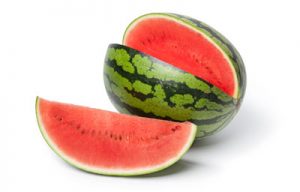
Look for a firm, symmetrical watermelon that is free from bruises, cuts or dents. The underside of the watermelon should have a creamy yellow spot where it sat on the ground and ripened in the sun.
Storing watermelon
Keep in the fridge once cut
Water melon recipes
Did you know that the rind is also edible with the white part good to eat and the green rind used as a vegetable, stir fried, stewed or pickled?
Watermelon cakes
There are so many fun and easy ways of creating healthy celebration cakes for any age. There are plenty of amazing creative designs on the internet.

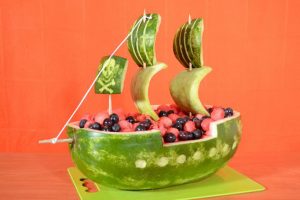
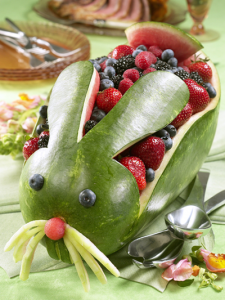
Spicy Watermelon Salsa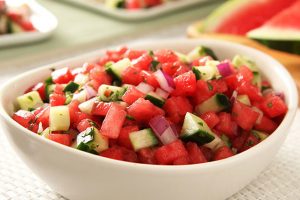
Serves: 16
1/2 large watermelon, seeds removed and coarsely chopped
1 red onion, chopped
1 red chilli, seeds removed and chopped
handful chopped coriander leaves or mint
2 tablespoons balsamic vinegar
pinch salt
In a serving bowl, mix together all ingredients. Cover and refrigerate for at least 1 hour to meld flavours.
Watermelon Fizz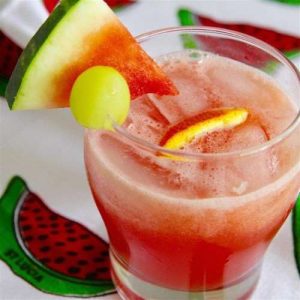
1 cup coconut water
1/2 cup watermelon puree
1 teaspoon stevia
1/2 cup ice cubes, or as desired
Blend coconut water, watermelon, and stevia together in a blender until smooth.
Fill a cocktail shaker with ice then add the watermelon mixture.
Shake and chill then pour into a tall glass. Garnish with an orange twist, watermelon wedge, and grapes
Watermelon Ice Blocks
Blend watermelon flesh into liquid. A little shredded mint added or blended with the water melon is delicious. Pour. Freeze.

Wow because this is excellent job! Congrats and keep it up.
Very beneficial looking onward to coming back.
Thanks Brian
It’s actually a nice and useful piece of information. I am glad that you just shared this helpful information with us.
Please keep us informed like this. Thanks for sharing.
We’re glad you liked it, thanks for the feedback. NHSA Team
Very good post. I’m facing many of these issues as well..
Thanks!